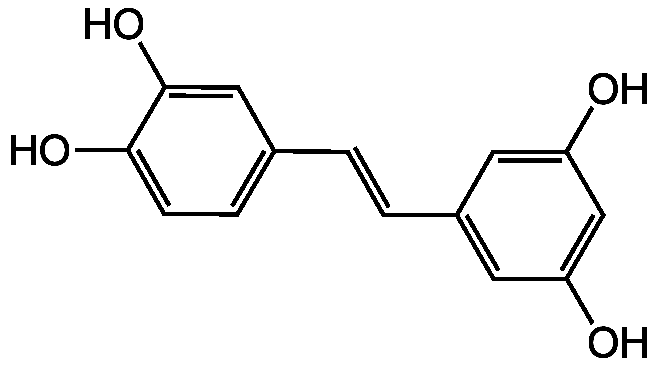Piceatannol
Product Code: AG-CN2-0086
Product Group: Natural Products and Extracts
Supplier: AdipoGen Life Sciences
| Code | Size | Price |
|---|
| AG-CN2-0086-M001 | 1 mg | £40.00 |
Quantity:
| AG-CN2-0086-M005 | 5 mg | £50.00 |
Quantity:
| AG-CN2-0086-M025 | 25 mg | £150.00 |
Quantity:
Prices exclude any Taxes / VAT
Overview
Regulatory Status: RUO
Shipping:
Ambient
Storage:
+4°C
Images
Documents
Further Information
Alternate Names/Synonyms:
CCRIS 9289; NSC365798; NSC622471; 3,3',4,5'-Tetrahydroxy-trans-stilbene; 3-Hydroxyresveratrol
Appearance:
Off-white to light pink crystalline solid.
CAS:
10083-24-6
EClass:
32160000
Form (Short):
liquid
Handling Advice:
Protect from light and moisture.
InChi:
InChI=1/C14H12O4/c15-11-5-10(6-12(16)8-11)2-1-9-3-4-13(17)14(18)7-9/h1-8,15-18H/b2-1+
InChiKey:
CDRPUGZCRXZLFL-OWOJBTEDBC
Long Description:
Chemical. CAS: 10083-24-6. Formula: C14H12O4. MW: 244.3. Synthetic. Originally isolated from Euphorbia lagascae. Wide range of tyrosine and serine/threonine protein kinase inhibitor, including Syk, p56lck, PKA, PKC, MLCK, CDPK, JNK and PI3K. Inhibits the tyrosine phosphorylation of STAT3 and STAT5. Potent apoptosis inducer. Potent anticancer compound. Suppresses NF-kB activation through IkBalpha kinase inhibition. Activator of human deacetylase SIRT1 (sirtuin 1). Potent antioxidant with anti-proliferative, anti-inflammatory and cardioprotective properties. Neuoprotective. Adipogenesis inhibitor. Promotes glucose uptake, AMPK phosphorylation and GLUT4 translocation. Autophagy inducer
MDL:
MFCD00221715
Molecular Formula:
C14H12O4
Molecular Weight:
244.3
Package Type:
Vial
Product Description:
Wide range of tyrosine and serine/threonine protein kinase inhibitor, including Syk, p56lck, PKA, PKC, MLCK, CDPK, JNK and PI3K [1-3, 9, 14, 15]. Inhibits the tyrosine phosphorylation of STAT3 and STAT5 [4]. Potent apoptosis inducer [5]. Potent anticancer compound [6, 10, 16, 17]. Suppresses NF-kB activation through IkBalpha kinase inhibition [7]. Activator of human deacetylase SIRT1 (sirtuin 1) [8]. Potent antioxidant with anti-proliferative, anti-inflammatory and cardioprotective properties [10, 14, 15, 17, 19]. Neuoprotective [11, 14]. Adipogenesis inhibitor [18]. Promotes glucose uptake, AMPK phosphorylation and GLUT4 translocation [20]. Autophagy inducer [21]
Purity:
>98% (HPLC)
SMILES:
OC1=CC(C=CC2=CC=C(O)C(O)=C2)=CC(O)=C1
Solubility Chemicals:
Soluble in DMSO, dimethyl formamide, ethanol, methanol, acetone or ethyl acetate. Slightly soluble in water.
Source / Host:
Synthetic. Originally isolated from Euphorbia lagascae.
Transportation:
Non-hazardous
UNSPSC Category:
Natural Products/Extracts
UNSPSC Number:
12352200
Use & Stability:
Stable for at least 2 years after receipt when stored at +4°C.
References
Piceatannol (3,4,3',5'-tetrahydroxy-trans-stilbene) is a naturally occurring protein-tyrosine kinase inhibitor: R.L. Geahlen, et al.; BBRC 165, 241 (1989) | Inhibition of mast cell Fc epsilon R1-mediated signaling and effector function by the Syk-selective inhibitor, piceatannol: J.M. Oliver, et al.; J. Biol. Chem. 269, 29697 (1994) | Inhibition of eukaryote serine/threonine-specific protein kinases by piceatannol: B.H. Wang, et al.; Planta Med. 64, 195 (1998) | Distinct mechanisms of STAT phosphorylation via the interferon-alpha/beta receptor. Selective inhibition of STAT3 and STAT5 by piceatannol: L. Su & M. David; J. Biol. Chem. 275, 12661 (2000) | Piceatannol, a hydroxylated analog of the chemopreventive agent resveratrol, is a potent inducer of apoptosis in the lymphoma cell line BJAB and in primary, leukemic lymphoblasts: T. Wieder, et al.; Leukemia 15, 1735 (2001) | Piceatannol, a natural analog of resveratrol, inhibits progression through the S phase of the cell cycle in colorectal cancer cell lines: F. Wolter, et al.; J. Nutr. 132, 298 (2002) | Piceatannol inhibits TNF-induced NF-kappaB activation and NF-kappaB-mediated gene expression through suppression of IkappaBalpha kinase and p65 phosphorylation: K. Ashikawa, et al.; J. Immunol. 169, 6490 (2002) | Small molecule activators of sirtuins extend Saccharomyces cerevisiae lifespan: K.T. Howitz, et al.; Nature 425, 191 (2003) | Piceatannol upregulates endothelial heme oxygenase-1 expression via novel protein kinase C and tyrosine kinase pathways: B.S. Wung, et al.; Pharmacol. Res. 53, 113 (2006) | Antioxidant activity of resveratrol, piceatannol and 3,3',4,4',5,5'-hexahydroxy-trans-stilbene in three leukemia cell lines: Z. Ovesna, et al.; Oncol. Rep. 16, 617 (2006) | Protective effects of piceatannol against beta-amyloid-induced neuronal cell death: H.J. Kim, et al.; Ann. N Y Acad. Sci. 1095, 473 (2007) | Piceatannol inhibits melanogenesis by its antioxidative actions: T. Yokozawa & Y.J. Kim; Biol. Pharm. Bull. 30, 2007 (2007) | Induction of apoptosis by piceatannol in human leukemic U937 cells through down-regulation of Bcl-2 and activation of caspases: Y.H. Kim, et al.; Oncol. Rep. 19, 961 (2008) | Piceatannol attenuates 4-hydroxynonenal-induced apoptosis of PC12 cells by blocking activation of c-Jun N-terminal kinase: Y.J. Jang, et al.; Ann. N Y Acad. Sci. 1171, 176 (2009) | Phosphoinositide 3-kinase is a novel target of piceatannol for inhibiting PDGF-BB-induced proliferation and migration in human aortic smooth muscle cells: K.H. Choi, et al.; Cardiovasc. Res. 85, 836 (2010) | Piceatannol inhibits migration and invasion of prostate cancer cells: possible mediation by decreased interleukin-6 signaling: G.T. Kwon, et al.; J. Nutr. Biochem. 23, 228 (2012) | Biological activity of piceatannol: leaving the shadow of resveratrol: H. Piotrowska, et al.; Mutat. Res. 750, 60 (2012) (Review) | Piceatannol, natural polyphenolic stilbene, inhibits adipogenesis via modulation of mitotic clonal expansion and insulin receptor-dependent insulin signaling in early phase of differentiation: J.Y. Kwon, et al.; J. Biol. Chem. 287, 11566 (2012) | Antiproliferative and anti-invasive effect of piceatannol, a polyphenol present in grapes and wine, against hepatoma AH109A cells: Y. Kita, et al.; J. Biomed. Biotechnol. 2012, 672416 (2012) | Piceatannol, a resveratrol derivative, promotes glucose uptake through glucose transporter 4 translocation to plasma membrane in L6 myocytes and suppresses blood glucose levels in type 2 diabetic model db/db mice: M. Minakawa, et al.; BBRC 422, 469 (2012) | Pro-autophagic polyphenols reduce the acetylation of cytoplasmic proteins: F. Pietrocola, et al.; Cell Cycle 11, 3851 (2012)



